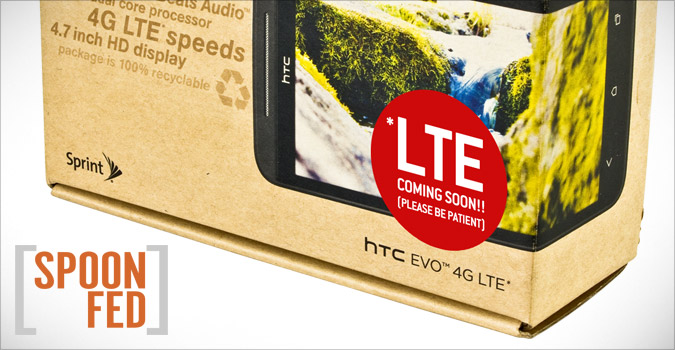4G Reality Check: Beware of These Cons and Lies

Anyone in the market for a smartphone these days will likely see the term 4G shoved in their face by the major carriers. "We have the biggest network!" "We have the fastest speeds!" Sometimes the providers back up their claims with blazing fast data and great coverage, but other times, consumers will wind up feeling cheated. Here are some examples in which the reality simply doesn't live up to the marketing hype.
Sprint's 4G LTE Phones: Hurry Up and Wait
The nation's third-largest carrier finds itself in serious catchup mode against Verizon Wireless and AT&T. Sprint is launching its 4G LTE service in six cities this summer, while Verizon already has more than 250 markets lit up and AT&T has 35 and counting. So what do you do in the meantime?
If you're Sprint, you launch phones with 4G LTE in the name that don't yet offer those speeds anywhere. Devices such as the HTC Evo 4G LTE and LG Viper 4G LTE don't even connect to Sprint's older WiMax network. For now, they're 3G only. I gave Sprint a pass back in 2010 with the original Evo 4G because the carrier was first to market. Now the game has changed.
I think it's great that Sprint will be the only provider offering unlimited 4G data, but right now, the names of these phones feel downright misleading. At the very least, Sprint should be more transparent about which cities will be getting LTE service after the first six markets launch, so shoppers will know when coverage is coming to their neck of the woods.
[Inside Sprint's 4G Comeback Plan: Will it Work?]
The Faux G iPhone
Stay in the know with Laptop Mag
Get our in-depth reviews, helpful tips, great deals, and the biggest news stories delivered to your inbox.
Did you know you could get a 4G iPhone in the U.S. right now? No, the iPhone 5 didn't just launch. It's just that the recent iOS update to the iPhone 4S on AT&T changed the 3G icon to 4G at the top of the screen.
Alas, the phone didn't get any faster; it's just that Apple's software now reports AT&T's HSPA+ network as a 4G network, just as the carrier's many Android phones do. In our tests, AT&T's iPhone 4S was indeed faster than Sprint's and Verizon's models, but the speeds pale in comparison to AT&T's newer 4G LTE network.
As anyone who has used the AT&T iPhone in a dense urban area knows, speeds can slow to the point where you have to wait 30 seconds for the contents of an email to load. That's not 4G to me, making this one "upgrade" I could do without.
[iPhone 4S Carrier Shootout: AT&T vs. Sprint vs. Verizon]
T-Mobile's Rigged Test Drive
Of all the major carriers, T-Mobile is furthest behind in deploying a 4G LTE network, which won't get off the ground until 2013. In the meantime, the carrier does have a HSPA+ 4G network that offers vast coverage and pretty good speeds. So why would you sabotage that with bad marketing?
T-Mobile has set up a website that invites people to test drive its network versus the competition. Unfortunately, the carrier chose the 3G iPhone 4S from Sprint and Verizon and the faux G iPhone 4S from AT&T as the basis for comparison. Of course T-Mobile's 4G phones are going to wipe the floor with these devices when it comes to streaming movies and downloading apps. It's simply not a fair fight.
The HTC One S from T-Mobile we recently tested delivered downloads as high as 9.5 Mbps and uploads as fast as 3.2 Mbps, which are actually well within the claimed range of 4G LTE. On the other hand, T-Mobile's performance can be quite inconsistent, depending on where you are. In front of a T-Mobile store transfer rates were as low as .1 Mbps down and .6 Mbps up.
T-Mobile should just stick with its 4G-for-less-money message and leave the fixed fights to the WWE.
Bottom Line
If you want the fastest speeds on a smartphone right now, Verizon Wireless and AT&T are your best bet. With Verizon, it's easy for shoppers, because the carrier offers only one flavor of 4G in LTE, and you get consistently fast data in the most cities. With AT&T, it's more complicated because there are two varieties of 4G: HSPA+ and LE. Go with a phone that offers real 4G--LTE--like the HTC One X, if you want the best performance. Should you avoid 4G phones from the other carriers? Of course not, but you should know what you're getting — and what's missing.
Editor-in-chief Mark Spoonauer directs LAPTOP's online and print editorial content and has been covering mobile and wireless technology for over a decade. Each week Mark's SpoonFed column provides his insights and analysis of the biggest mobile trends and news. You can also follow him on Twitter.

